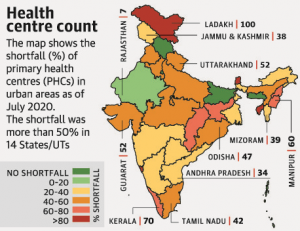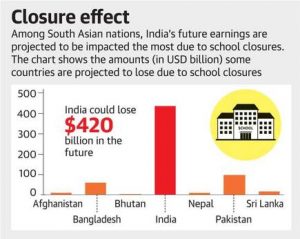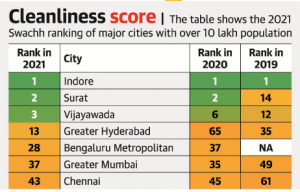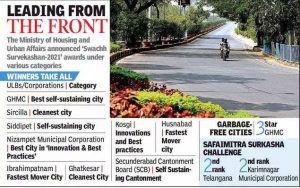POLITY, GOVERNANCE AND SOCIAL JUSTICE
1. POLICE COMMISSIONERATE SYSTEM IN BHOPAL & INDORE
THE CONTEXT: Madhya Pradesh Chief Minister announced the implementation of a Police Commissionerate system in Bhopal and Indore.
THE EXPLANATION:
The system gives more responsibilities, including magisterial powers, to IPS officers of Inspector General of Police (IG) rank posted as commissioners. Depending on its success here, the policing system may gradually be implemented in other districts as well.
What is the Police Commissionerate system?
- Under the 7th Schedule of the Constitution, ‘Police’ is under the State list, meaning individual states typically legislate and exercise control over this subject. In the arrangement in force at the district level, a ‘dual system’ of control exists, in which the Superintendent of Police (SP) has to work with the District Magistrate (DM) for supervising police administration.
- At the metropolitan level, many states have replaced the dual system with the Commissionerate system, as it is supposed to allow for faster decision-making to solve complex urban-centric issues.
- In the Commissionerate system, the Commissioner of Police (CP) is the head of a unified police command structure, is responsible for the force in the city, and is accountable to the state government. The office also has magisterial powers, including those related to regulation, control, and licensing.
- The CP is drawn from the Deputy Inspector General rank or above and is assisted by Special/Joint/Additional/Deputy Commissioners.

How many states have it?
Almost all states barring Bihar, UT of J&K, and some North-eastern states have a Commissionerate system. The British brought the system first in Kolkata and followed it in Mumbai and Chennai presidencies. Delhi turned into a Commissionerate during the Morarji Desai regime. In 1978, an initiative to introduce the system in UP, beginning with Kanpur, never materialised.
What is different under the system?
- Policing is based on the Police Act of 1861. Under the colonial system, the overall in-charge of a district or region was the district collector; the SP reported to him. The powers of the executive magistrate, such as issuing orders for preventive arrests or imposition of Section 144 CrPC, were vested in the district collector. This was called the dual system of police administration.
- “The primary objective of the British was revenue collection in rural India. They needed a force that could support this objective and unleash tyranny and oppression when needed to suit the objective. The worst of officers from the British police were sent to India. So, there was need to put them under the District Collector.
2. LIFE EXPECTANCY LOWER FOR URBAN POOR, SAYS STUDY
THE CONTEXT: A report released recently by Azim Premji University in collaboration with 17 regional NGOs across India stated that Life expectancy among the poorest is lower by 9.1 years among men and 6.2 years among women from the corresponding figures for the richest in urban areas.
THE EXPLANATION:
- The report, “Healthcare equity in urban India”, explores health vulnerabilities and inequalities in cities in India. It also looks at the availability, accessibility and cost of healthcare facilities, and possibilities in future-proofing services in the next decade.
- It notes that a third of India’s population lives in urban areas, with this segment seeing rapid growth from about 18% (1960) to 28.53% (2001) and 34% (in 2019). Close to 30% of people living in urban areas are poor.
- This also included an analysis of the National Family and Health Surveys, the Census, and inputs from State-level officials on the provision of healthcare.
- The report, besides finding disproportionate disease burden on the poor, also points to chaotic urban health governance, where the multiplicity of healthcare providers both within and outside the Government without coordination challenges urban health governance.
- The other key findings include a heavy financial burden on the poor and less investment in healthcare by urban local bodies.

Steps to be taken
- The report calls for strengthening community participation and governance; building a comprehensive and dynamic database on the health and nutrition status, including comorbidities of the diverse, vulnerable populations; strengthening healthcare provisioning through the National Urban Health Mission, especially for primary healthcare services; and putting in place policy measures to reduce the financial burden of the poor.
- It also advocates for a better mechanism for coordinated public healthcare services and better governed private healthcare institutions.
- “As urbanisation is happening rapidly, the number of the urban poor is only expected to increase. A well-functioning, better coordinated and governed healthcare system is crucial at this point”.
3. THE PROLONGED SCHOOL CLOSURES POSE THREAT TO GENDER EQUALITY: STUDY
THE CONTEXT: According to the UNESCO study, the educational disruption due to prolonged closure of schools across the globe will not only have alarming effects on learning loss but also poses threat to gender equality.
THE EXPLANATION:
- The global study, titled “When schools shut: Gendered impacts of COVID19 school closures”, brings to the fore that girls and boys, young women and men were affected differently by school closures, depending on the context.
- “At the peak of the pandemic, 1.6 billion students in 190 countries were affected by school closures. Not only did they lose access to education, but also to the myriad benefits of attending school, at an unparalleled scale’.
- Drawing on evidence from about 90 countries and in-depth data collected in local communities, the report shows that gender norms and expectations can affect the ability to participate in and benefit from remote learning.
- “In poorer contexts, girls’ time to learn was constrained by increased household chores. Boys’ participation in learning was limited by income-generating activities. Girls faced difficulties in engaging in digital remote learning modalities in many contexts because of limited access to internet-enabled devices, a lack of digital skills and cultural norms restricting their use of technological devices.”
- “The longer girls were out of school, the higher was the risk of learning loss. From April to September 2020, the share of girls reporting that they did not study at all increased from 1 to 10 per cent,”.
- “To advance equal access to gender-responsive and inclusive remote learning, it is recommended to provide a range of remote learning options including low-tech and no-tech solutions spearhead and support efforts to reach the most at-risk learners design, develop gender-responsive educational resources and tools besides providing appropriate teacher support and training use formative assessments to track learning outcomes.

THE INTERNATIONAL RELATIONS
4. PAKISTAN’S NEW LAW ON ICJ
THE CONTEXT: On November 2021, Pakistan’s Parliament passed the International Court of Justice (Review and Reconsideration) Bill, 2021, granting the right of appeal to Kulbhushan Jadhav, former Indian Navy officer on death row on espionage and other charges.
THE EXPLANATION:
India expressed misgivings about the law, saying it still does not fulfil the terms laid down by the International Court of Justice (ICJ) in its July 2019 ruling which included the provision that India be allowed consular access to Jadhav.
When was he arrested?
- Kulbhushan Jadhav was arrested in March 2016 and charged with espionage and sabotage against Pakistan’s security installations. The case received attention as it came soon after the January 2016 Pathankot terror strike that India blamed on Pakistan-based terrorists.
- Pakistan blamed India for sponsoring cross-border terrorism targeting Balochistan. India maintained that Jadhav was a former Navy official and that he had been denied rightful access to legal counsel. The Pakistani law is another episode in the protracted legal process that began when India approached the ICJ.
What had India argued at the ICJ?
- India had argued at the ICJ in May 2017 that Jadhav had been denied his rights under the Vienna Convention and Pakistan had “failed to inform” New Delhi about his arrest. The law passed at a joint session of the two Houses of Pakistan’s parliament is being presented by the Imran Khan government as proof of Islamabad complying with the ICJ ruling.
What did the ICJ rule?
- In April 2017, a year after his arrest, Jadhav was sentenced to death by a military court in Pakistan for alleged acts of sabotage. India moved the ICJ and pointed out that Pakistan had failed to provide consular access to Jadhav.
- In its observations of May 18, 2017, the ICJ asked Pakistan to take “all measures at its disposal” to ensure that Jadhav is not executed pending its final decision. It observed that Pakistan had violated Article 36 of the Vienna Convention by not allowing India consular access to Jadhav and by denying his right to a proper legal representation.
Will this law help Jadhav access his legal counsel?
- The law will end up as mere paperwork if Pakistan fails to provide verifiable legal access to Jadhav. India has already expressed its misgivings.
- The Ministry of External Affairs said the law is a repeat of the International Court of Justice (Review and Reconsideration) Ordinance, 2020, that Delhi had rejected as inadequate for meeting the goals stated in the ICJ’s observations of July 2019.
- India said the ordinance did not “create the machinery of an effective review and reconsideration” as mandated by the ICJ.
- The Ministry of External Affairs pointed out in a statement that the law of November 2021 has actually codified the Ordinance of May 2020 without removing the shortcomings. India maintains that Pakistan cannot provide a “fair trial” for Jadhav.
Why has Pakistan made this move now?
- Pakistan’s Law Minister said Pakistan anticipated that India was planning to go to the ICJ again to file a contempt notice against Pakistan and that this law had averted or pre-empted this possible Indian move.
- Following this new law, Pakistan is likely to claim that it has not just complied with the verdict of the ICJ but has also enshrined it as a law. Pakistan’s former High Commissioner Abdul Basit has pointed out that Pakistan agreed to accept the jurisdiction of the ICJ during the government of Prime Minister Nawaz Sharif of the Pakistan Muslim League (Nawaz) and that the present government of Prime Minister is dealing with a legacy issue.
THE BACKGROUND
International Court of Justice
ICJ is a principal judicial organization of the United Nations (UN). It was established in 1945 by a UN Charter and began working in 1946 as the successor to the Permanent Court of International Justice. Headquartered at Hague, Netherlands. Notably, it is the only UN principal organ not situated in New York.
- All the 193 member states of the UN are automatically parties to the Court. Those nations that are not members of the UN may become parties to the Court’s statute with the help of the Article 93 procedure.
- The chief function of the ICJ is to settle disputes submitted by parties according to international law.
- The Court also gives advisory opinions on legal matters submitted by any of the UN bodies or specialized agencies.
- It settles legal disputes between member countries and gives advisory opinions to authorized UN Organs and Specialized Agencies.
- Its official language is English and French.
|
Vienna Convention: The Vienna Convention on Consular Relations is an international treaty that defines consular relations between independent states.
|
ICJ Jurisdiction
The ICJ has two types of jurisdictions:
- Contentious cases
- ICJ, in accordance with international law, settles disputes of legal nature that are submitted to it by states.
- Countries should apply and only then appear before the ICJ. International organisations, other authorities, and private individuals are not entitled to institute proceedings before the ICJ.
- The Court can only deal with a dispute when the States concerned have recognized its jurisdiction.
- The judgment is final, binding on the parties to the case and without an appeal.
- Advisory opinions
- The advisory procedure is available to five UN Organs, fifteen Specialized Agencies, and one Related Organisation.
- Despite having no binding force, the Court’s advisory opinions nevertheless, carry great legal weight and moral authority and thus help in the development and clarification of international laws.
THE SCIENCE & TECHNOLOGY
5. THE NUTRITIOUS & CLIMATE-RESISTANT CHANA SOON: ICRISAT
THE CONTEXT: Research led by scientists from International Crops Research Institute for the Semi-Arid Tropics (ICRISAT) in India is set to help produce more chickpea or chana and make it more nutritious and climate-change resistant.
THE EXPLANATION:
- Scientists from around the world have used genome sequencing to help produce new varieties of chickpea, which are expected to give increased yields at about similar input cost.
- The worldwide research project has made it possible to cultivate new varieties of one of the most consumed pulses in the world, in a number of forms. These varieties are expected to give increased yields of chanaat about similar input costs to current varieties, and the new crop is set to be less susceptible to damage, as well as tastier.
- The scientists used genome sequencing to produce these new varieties and made a knowledge bank that can be used for experiments to produce better chana in future. The research, the world’s largest on plant genome sequencing, was published earlier this week in the science journal Nature.
- In total, 29,870 genes were identified, out of which 1,582 were previously unreported genes. The research also provided the historical origins of chanaand the migratory paths the crop as it spread around the globe.
- After this study, chanais among a club of crops like rice, wheat, and maize for which there’s extensive genetic information, enabling future advances through applied genetic technology.
What is Genome Sequencing?
- Genome sequencing is a method used to determine the entire genetic makeup of an organism. The genetic study of crop varieties is then used for further improvement by scientific research and biotechnological methods.
GOVERNMENT SCHEMES/INITIATIVES IN NEWS
6. THE PRADHAN MANTRI AWAAS YOJANA – GRAMIN COMPLETES 5 YEARS
THE CONTEXT: On the eve of completion of 5 years of the scheme and celebration of Awaas Diwas on 20th November 2021. Ministry of Rural Development along with States/Uts undertake various activities to celebrate Awaas Diwas. Ensuring the fulfilment of the noble objective of housing for all, the Ministry in partnership with the State government endeavours to complete the target within the time frame.
THE EXPLANATION:
- To achieve the objective of providing “Housing to All” by the year 2022, the Government of India rolled out the revamped rural housing scheme, Pradhan Mantri Awaas Yojana-Gramin (PMAY-G) was launched on 20th November 2016 with effect from 1stApril 2016. The program envisages the completion of 2.95 crore PMAY-G houses with all basic amenities by the year 2022.
- Apart from focusing on providing houses to the eligible beneficiaries, PMAY-G also addresses the basic needs of households through convergence with other Government Schemes.
- The beneficiary is entitled to 90/95 person-days of unskilled labour from MGNREGS.
- The assistance for the construction of the toilet shall be leveraged through convergence with SBM-G. Convergence for piped drinking water, electricity connection, LPG gas connection etc. under different Government programmes is also an inherent thematic component.
- An exercise for identification of households, who though eligible for assistance under PMAY-G as per the parameters specified under SECC-2011 but have not been included in the list of eligible beneficiaries and creating an additional list of eligible households was carried out by the Ministry of Rural Development through the States / UTs using Mobile Application “Awaas+”. The survey was started in January 2018 and completed till 7thMarch, 2019.
- In total 3.57 crore households were captured in the Awaas+ survey. Out of which, 2.76 crores household were found eligible and 51.07 lakh has been allocated to States/UTs so far.
Funding Pattern
- Under PMAY, the cost of unit assistance is to be shared between Central and State Governments in the ratio 60:40 in plain areas and 90:10 for Northeastern and hilly states.
- The unit assistance given to beneficiaries under the programme is Rs 1,20,000 in plain areas and to Rs 1,30,000 in hilly states/difficult areas /Integrated Action Plan (IAP) for Selected Tribal and Backward Districts.
- The beneficiary is entitled to 90 days of unskilled labour from MGNREGA.
- The beneficiary would be facilitated to avail loan of up to 70,000/- for construction of the house which is optional.
- Funds will be transferred electronically directly to the account of the beneficiary.
Target Group
- Identification of beneficiaries eligible for assistance and their prioritisation to be done using information from Socio Economic and Caste Census (SECC) ensuring total transparency and objectivity.
- The list will be presented to Gram Sabha to identify beneficiaries who have been assisted before or who have become ineligible due to other reasons. The finalised list will be published.
MISCELLANEOUS
7. THE SWACHH SURVEKSHAN AWARDS 2021
THE CONTEXT: The President of India, addressed the Swachh Amrit Mahotsav and presented the Swachh Survekshan Awards 2021, being organised by the Ministry of Housing and Urban Affairs
THE BACKGROUND:
- Launched on October 1, 2020, the Swachh Bharat Mission-Urban 2.0 focuses on ensuring complete access to sanitation facilities for all.
- Over the years, the world’s largest urban cleanliness survey Swachh Survekshan has become an effective tool for innovations and best practices in sanitation and waste management across urban India.
THE EXPLANATION:
- In the State awards, Chhattisgarh, for the third consecutive yearemerged as the ‘Cleanest State’ in the category of “more than 100 Urban Local Bodies” while Jharkhand, for the second time, won the Cleanest State award in the “less than 100 ULBs category”. Karnataka and Mizoram became the ‘Fastest Mover States’ in the big (more than 100 ULBs) and small (less than 100 ULBs) state category respectively.
- Indore wins the title of ‘Cleanest City’ for fifth consecutive time under Swachh Survekshan
- Indore, Navi Mumbai, and Nellore emerge as Top Performers in SafaiMitra Suraksha Challenge. Also, In this year we have Nine 5-Star Cities, 143 Cities 3-Star Garbage Free Cities.
- Varanasi emerged as the ‘Best Ganga Town’while Ahmedabad Cantonment won the title of ‘India’s Cleanest Cantonment’, followed by Meerut Cantonment and Delhi Cantonment.
- In the category of ‘Fastest Mover’, Hoshangabad (Madhya Pradesh) emerged as the ‘Fastest Mover City’ (in the ‘more than 1 lakh population’ category) with a jump of 274 ranks from 361stposition in the 2020 rankings to the 87th position this year, thus securing a place among the top 100 cities.

Additionally, a futuristic and state-of-the-art spatial GIS platform was launched that will further propel the Mission towards smart, data driven decision making. This new digital enablements will further enable the Mission to become paperless, robust and transparent, along with round-the-clock connectivity with States, Cities and stakeholders across the Swachhata spectrum.

Compared to Swachh Survekshan 2020, the key improvements in performance states and cities in the Swachh Survekshan 2021 are:
- 6 States and 6 UTs have shown overall improvement,
- More than 1,100 additional cities have started source segregation,
- Nearly 1,800 additional Urban Local Bodies (ULBs) have started extending welfare benefits to their sanitation workers,
- More than 1,500 additional ULBs have notified ban on the use, sale, and storage of non-biodegradable plastic bags; in total, more than 3,000 ULBs have notified this ban,
- All Northeast states have shown significant improvement in their citizens’ feedback
Under this survey, cities have been ranked based on 71 sanitation related parameters with different weightages for a total of 4,000 marks. Total score has been doubled this time to avoid crowding of cities with very marginal differences in scores that happened in the previous survey.
THE EXCLUSIVE PRELIMS FACTS
8. THE MINSK PROTOCOL (2014)
- The Minsk Protocol is an agreement which sought to end war in the Donbas region of Ukraine. It was written by the Trilateral Contact Group on Ukraine, consisting of Ukraine, the Russian Federation, and the Organization for Security and Co-operation in Europe (OSCE), with mediation by the leaders of France and Germany in the so-called Normandy Format.
- After extensive talks in Minsk, Belarus, the agreement was signed by representatives of the Trilateral Contact Group and, without recognition of any status, by the then heads of the Donetsk People’s Republic and Luhansk People’s Republic.
PRELIMS PRACTICE QUESTIONS
- Which one of the following best defines the term ‘state’?
a) A community of persons permanently occupying a definite territory independent of external control and possessing an organized government.
b) A politically organised people of a definite territory and possessing an authority to govern them, maintain law and order, protect their natural rights and safeguard their means of sustenance.
c) A number of persons who have been living in a definite territory for a very long time with their own culture, tradition and government
d) A society permanently living in a definite territory with a central authority, an executive responsible to the central authority and an independent judiciary
ANSWER FOR NOVEMBER 20th, 2021 PRELIMS PRACTICE QUESTIONS
Answer: B
Explanation:
- Liberty and privacy guaranteed under Article 21, to marry and live independently as manand woman without the interference of their family or others.
Spread the Word


